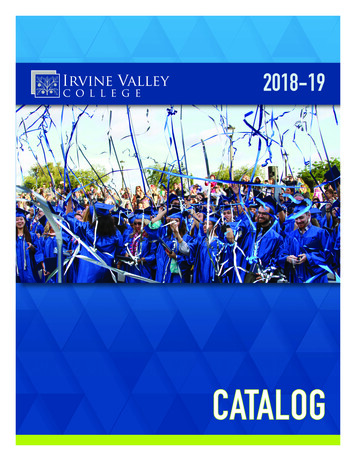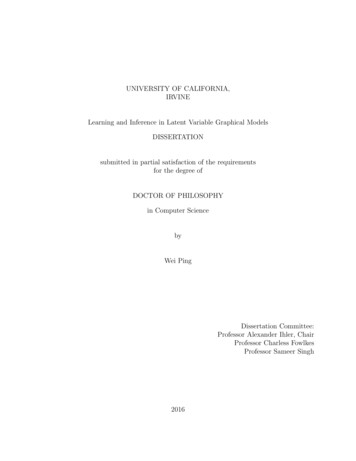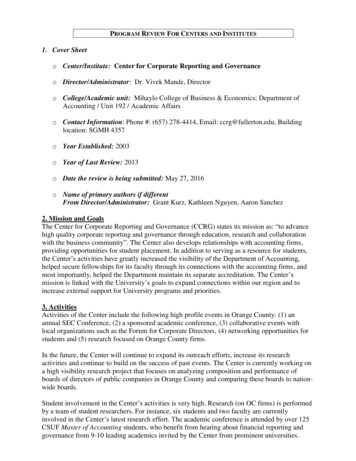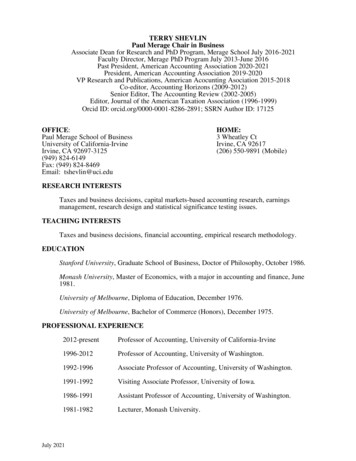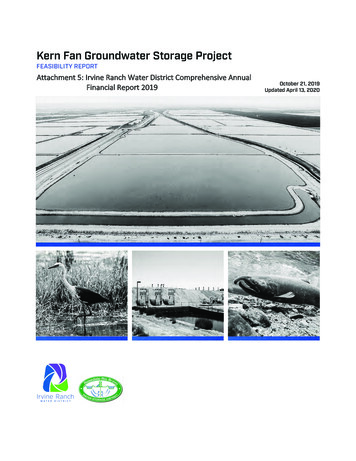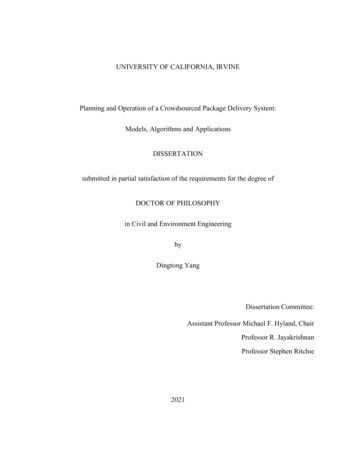
Transcription
UNIVERSITY OF CALIFORNIA, IRVINEPlanning and Operation of a Crowdsourced Package Delivery System:Models, Algorithms and ApplicationsDISSERTATIONsubmitted in partial satisfaction of the requirements for the degree ofDOCTOR OF PHILOSOPHYin Civil and Environment EngineeringbyDingtong YangDissertation Committee:Assistant Professor Michael F. Hyland, ChairProfessor R. JayakrishnanProfessor Stephen Ritchie2021
2021 Dingtong Yang
DEDICATIONTo my parents, Prof. Weiping Yang and Ms. Min Ding.To my grandmother, Ms. Yulan Dingii
TABLE OF CONTENTSLIST OF FIGURES . VLIST OF TABLES . VIIACKNOWLEDGEMENTS . VIIICURRICULUM VITAE. XABSTRACT OF THE DISSERTATION . XIICHAPTER 1 INTRODUCTION . 11.1Overview of crowdsourced freight delivery. 11.2Motivations of the dissertation . 41.3Problem statements, research questions and contributions . 71.4Dissertation outline . 9CHAPTER 2 CONCEPTUAL FRAMEWORK AND LITERATURE REVIEW . 122.1Urban freight crowdsourced delivery . 122.2Terminology . 192.3Literature review . 20CHAPTER 3 FORMULATING THE CROWDSOURCED SHARED-TRIP PROBLEM 363.1Problem Description . 363.2m-VRPTW based formulation . 383.3Set-partitioning formulation . 44CHAPTER 4 SOLUTION ALGORITHM . 474.1Solution algorithm overview . 474.2Budgeted k-shortest path . 53iii
4.3Large-scale matching problem of packages and vehicles . 564.4Solving the vehicle routing problem . 594.5Decision of package switching – cost driven approach . 624.6Computational results comparison . 664.7Summary of the solution algorithms . 70CHAPTER 5 APPLICATION OF MODELS AND ALGORITHMS: A CASE STUDY INTHE CITY OF IRVINE . 725.1Introduction . 725.2Literature review and background information . 735.3Case study settings . 765.4Results . 785.5Minimum compensation required . 965.6Summary of findings and implementations . 103CHAPTER 6 INCENTIVE AND OPERATIONAL POLICIES IN CROWDSOURCEDFREIGHT DELIVERY . 1066.1Introduction . 1066.2Background information and literature review . 1096.3Methodology . 1106.4Summary and discussion of future research . 115CHAPTER 7 CONCLUSIONS. 1167.1Conclusions . 1167.2Future research directions . 118BIBLIOGRAPHY . 120APPENDIX A MATHEMATICAL NOTATIONS USED IN THIS DISSERTATION. 129iv
LIST OF FIGURESFigure 1.1 Three Key Factors of Crowdsourced Delivery . 3Figure 1.2 E-commerce Volume in USA (2017 – 2025) . 5Figure 2.1 Freight share-a-trip delivery . 17Figure 2.2 Relations between different crowdsourced delivery and traditional truck delivery . 18Figure 3.1 Detour Distance of SPVs . 38Figure 3.2 Three Types of Shared Vehicle Routes . 39Figure 4.1 Average Package Delivery Cost by Truck . 64Figure 5.1 Process of crowdsourced shared-trip delivery. 73Figure 5.2 Factors that affects crowdsourced shared-trip delivery . 75Figure 5.3 Irvine Network. Depot and Package Locations . 76Figure 5.4 Package served by SPVs and trucks . 79Figure 5.5 Cost Comparison . 81Figure 5.6 Average Cost of Package Delivery. 81Figure 5.7 VMT from Package Delivery . 84Figure 5.8 VMT under different origins of SPVs . 85Figure 5.9 The number of packages served by routes with different detours . 87Figure 5.10 Cost Comparison over Detour Willingness . 89v
Figure 5.11 Maximum delivery orders that SPVs could serve . 90Figure 5.12 SPV usage under different maximum detour willingness . 92Figure 5.13 Cost Comparison over Different Depots . 94Figure 5.14 VMT Comparison over Different Depots. 95Figure 5.15 Feasible SPV percentages and SPV served packages . 95Figure 5.16 Minimum acceptable compensation valued by a constant . 100Figure 5.17 Minimum acceptable compensation to deliver valued by VOT . 101Figure 5.18 Crowdsourced time-shared delivery . 102Figure 6.1 Three crowdsourced delivery types and dedicated delivery. 107vi
LIST OF TABLESTable 2.1 Types of Urban Crowdsourced Delivery and Examples . 12Table 2.2 Comparison between urban crowdsourced delivery and traditional delivery. 18Table 2.3 Comparison with other crowdsourced shared-trip delivery studies. 31Table 4.1 Experiment setting . 66Table 4.2 Computational results comparison between decomposition heuristic and exact m-VRP. 69Table 5.1 Summary of parameter values for numerical study . 78Table 5.2 Delivery cost by SPVs and trucks. 83Table 5.3 VMT for package delivery . 86vii
ACKNOWLEDGEMENTSAt the very beginning, I would like to thank my parents for raising me, educating me andsupporting me for this PhD study. I would also like to thank my grandmother, a middle schoolbiology teacher, for cultivating my interest in natural science in my early childhood.I would like to express my thank to my chair supervisor, Prof. Michael F. Hyland. I should haveasked him the full form of “F” before writing this acknowledgement, but here I will take it as“fantastic” since he is more than a fantastic advisor. He is a great mentor and a good friend. Mikestarted to supervise me in my fourth year of PhD. It was also the first year that he came to UCI asan assistant professor. I really appreciate his help in research questions discussion, financialsupport and paper writing.I would also like to express my thank to my co-advisor, Prof. Radhakrishnan Jayakrishnan Nair.He is a smart free-thinker and cares about students. I like his way of teaching and appreciate hishelp in multiple aspects throughout my PhD study.I would like to thank my MPhil supervisor Dr. Tsz Leung Yip. He is the one who guide me tostart my career in research. Without his help and encouragement, I could not be a PhD today.I would like to thank Prof. Stephen Ritchie for being my research committee member anddedicating his energy to the entire UCI ITS as the director. I also need to thank both Prof.Wilfred Recker and Prof. John Tuner for their teaching and being my qualifying exam committeemembers. I would also thank Prof. Wen-Long Jin, Prof. Rick So and Prof. Jan Brueckner fortheir teaching and help in my PhD study.I could not survive my PhD study without the support of my friends. On the top of the list, Iwould like to thank Dr. Dongshu Liu, Chang Liu, Enguo Zhang and Dr. Rongheng Li for theirhelp in different issues in these years. I would like to thank my friend Navjyoth JayashankaSarma Shoba for coopering in different research projects with me.My colleagues from the research group also provided a lot of help and I would like toacknowledge their contributions here. I would like to thank my senior students Dr. Neda Masoud,Dr. Roger Lloret, Dr. Jiangbo Yu, Dr. Daisik Nam for helping me in my study and research. Iviii
would also like to thank my colleagues Sunghi An, Eduardo Malino, Marjan Mosslemi,Pengyuan Sun and Negin Shariat for their support in different research projects.I would also like to thank the support of the Civil Engineering Department and the Institute ofTransportation Studies. I would like to thank Dr. Zhe Jared Sun and Dr. Andre Tok for theirsupport in facility management. I would like to thank my friends in the department for spendingtime together. I would like to thank Dr. Yiqiao Li, Koti Reddy Allu, Yue Yu, Dr. Youngeun Bae,Lu Xu (and her husband Dr. Jin Yang), Arash Ghaffar, the Casebolt family (Chenying, Brian andlittle Thomas), Ximeng Fan, Guoliang Feng and Siwei Hu. I would also like to thank my seniorstudents who graduated and left UCI. They are Dr. Xuting Wang, Dr. Qinglong Yan, Dr. ShengHsiang Peng, Dr. Suman Kumar Mitra (the first person I know in UCI), Dr. Felipe de Souza, Dr.Karina Hermawan, Dr. Xiaoxia Shi, Dr. Jun Hyeong Park, Dr. Yunwen Feng and Dr. RijuLavanya. Wish them all the best after PhD.I would like to express my sincere thanks to Shirley Hsiao and Gabriella Marquez from LongBeach Transit. Thanks for your support in research projects and my intern. I would also thankmy friends who provide a lot of remote love and help. I would like to thank Danfeng Guo and Dr.Di Wu for helping me in different computer science and machine learning questions. I would liketo thank Feier Chen, Yuhang Lai and Chenge Jia for discussing different issues about life andbrings me a lot of joy. I would also like to thank my cousin, Yanni Liu, for her support duringthese years. I need to thank my friend Dr. Xun Tong, Dr. Yefei Yang and Dr. Sida Luo for theirhelp and support. Wish all of them the best in life.Finally, I would like to thank myself for making the decision of pursuing a PhD in life. It isalways enjoyable for me to learn knowledge. If I were not a PhD in transportation engineering, Iwould have attempted for linguistics.-Written on the Thanksgiving Day of 2021 in Irvine-ix
CURRICULUM VITAEDingtong YangEDUCATION2021PhD in Civil and Environmental EngineeringUniversity of California, IrvineIrvine, California, USA2016MPhil in Business AdministrationThe Hong Kong Polytechnic UniversityHong Kong SAR, ChinaMSc in Industrial Engineering and Logistics ManagementThe University of Hong Kong2013Hong Kong SAR, ChinaBBA in Supply Chain Management (First Class Honors)The Hong Kong Polytechnic University2012Hong Kong SAR, ChinaREFERRED JOURNAL PUBLICATIONSDynamic modeling and real-time management of a system of EV fast-2021Transportationcharging stationsD Yang, NJS Sarma, MF Hyland, R JayakrishnanResearch Part CEco-driving algorithm with a moving bottleneck on a single-lane roadP Sun, D Yang, WL Jin2020TransportationResearch RecordDesigning a transit-feeder system using multiple sustainable modes: Peer-to-2018Transportationpeer (P2P) ridesharing, bike sharing, and walkingD Nam, D Yang, S An, JG Yu, R Jayakrishnan, N MasoudxResearch Record
REFERRED CONFERENCE PROCEEDINGS2021Effective and Efficient Fleet Dispatching Strategies for DynamicallyMatching AVs to Travelers in Large-scale Transportation SystemsrdIEEE 23 ITSCNJS Sarma, D Nam, MF Hyland, F de Souza, D Yang, A Ghaffar, I Verbas2019A Practical Data-Driven Approach to Analyze Inter-agency PassengerTransfer with GTFS Data: A Case Study of the City of Long BeachthTRB 98 AnnualMeetingD Yang, R Jayakrishnan2018An Implementation-Ready Approach for Multiple-Van Multi-CriteriaDynamic Demand Rebalancing at Bike-Share StationsJG Yu, D Yang, D Nam, S An, R JayakrishnanthTRB 97 AnnualMeetingxi
ABSTRACT OF THE DISSERTATIONPlanning and Operation of a Crowdsourced Package Delivery System:Models, Algorithms and ApplicationsbyDingtong YangDoctor of Philosophy in Civil and Environmental EngineeringUniversity of California, Irvine, 2021Professor Michael F. Hyland, ChairOnline shopping has increased steadily over the past decade that has led to a dramatic increase inthe demand for urban package deliveries. Crowdsourced delivery, or crowd shipping, has beenproposed and implemented by logistics companies in response to the growth in package deliverybusiness. Crowdsourced delivery is a delivery service in which logistics service providerscontract delivery services from the public (i.e., non-employees), instead of providing deliveryservices exclusively with an in-house logistics workforce.This dissertation studies different types of urban last-mile crowdsourced delivery services andprovides a taxonomy for crowdsourced package delivery. Urban package crowdsourced deliverycan be categorized in terms of the way packages are delivered and the role/tasks of crowdsourceddrivers. Given these two dimensions, this study identifies three types of urban packagecrowdsourced delivery, namely, crowdsourced time-based delivery, crowdsourced trip-baseddelivery, and crowdsourced shared-trip delivery. Crowdsourced time-based delivery drivers arepaid for their idle time and work as sub-contractors. Crowdsourced trip-based delivery matchesdrivers with individual tasks and utilizes the drivers for specific delivery trips. The last type,xii
crowdsourced shared-trip delivery utilizes the common segments of a crowdsourced personalvehicle trip to deliver packages. In this type, the package shares part of the driver’s trip.The literature formulates the crowdsourced delivery problem as a Vehicle Routing Problem(VRP) and proposes a variety of solution approaches. However, all the solution algorithms arelimited to relatively small-scale problems. In addition, the factors that impact the efficiency andeffectiveness of crowdsourced delivery have not been thoroughly analyzed. To bridge the gap incrowdsourced delivery and urban freight logistics, this dissertation provides an alternativeformulation for the static crowdsourced shared-trip delivery problem and proposes a noveldecomposition heuristic to solve the problem.The alternative formulation is based on the set partitioning problem. The novel decompositionheuristic handles packages that are served by shared personal vehicles (SPVs) and dedicatedvehicles (DVs), separately. After that, the algorithm deploys a package switch procedure, whichrearranges packages between SPVs and DVs. The dissertation discusses various algorithmsemployed to solve different sub-problems, such as the budgeted k-shortest path, large scale bipartite matching, decision of package switching, and vehicle routing.To validate the models and algorithms, this dissertation presents a numerical case study that usesthe network of the City of Irvine, CA, USA. The results of the numerical study unveil interestingresults that are valuable to both researchers and industrial practitioners. The results indicate thatcrowdsourced shared-trip delivery service can reduce total delivery costs by between 20% to50%, compared to a delivery service that exclusively uses its own dedicated vehicles and drivers.However, the results show that dedicated vehicles are still required since the shared vehicles arenot able to serve all packages even with a considerably large set of candidate shared vehicles.Vehicle Miles Traveled (VMT) savings depend on the crowdsourced driver selection and theirxiii
trip origins. The dissertation also analyzes and discusses important factors that impact theeffectiveness of crowdsourced delivery. In particular, the dissertation includes sensitivityanalysis results with respect to changes in the depot location and the willingness of sharedvehicles to detour.xiv
Chapter 1 Introduction1.1Overview of crowdsourced freight deliveryThis dissertation explores a novel way of conducting urban freight delivery service,crowdsourced delivery, which is sometimes named as “crowd shipping” or “delivery with ad hocdrivers”. The term “crowdsourced” indicates that vehicles, and more importantly, driver-hoursare sourced from the general public.Crowdsourcing might not be a brand-new idea in the field of transportation studies and isdefinitely not a new concept in the human history. Two hundred years ago, in the financialindustry, this idea was applied for mutual fund raising and insurance purchasing. Moreover,when the website Wikipedia was first launched in 2001, the website sourced information andknowledge from the general public.In the transportation service sector, the concept of crowdsourcing become prominent with theintroduction and growth of transportation network companies (TNCs). TNCs source passengertransportation service to essentially anyone with a vehicle and a smartphone. TNC services aresimilar to traditional carpooling and ride-sharing services wherein, in the latter services, a driverutilizes the extra capacity (i.e., seats) in their vehicle to transport passengers whose tripsoriginate and terminate at locations that do not require the driver to detour too much from theiroriginal route. However, while traditional ride-sharing and carpooling services often requiredrivers and riders to agree on pickup location and pickup time at least an hour or two before thedriver began their trip, the ubiquity of smartphones allows ride-sharing services to dynamicallymatch potential riders and drivers who are traveling in a similar direction. This dissertation1
extends the concept of dynamic ride-sharing for people to ride-sharing or ride-crowdsourcing forparcels.Crowdsourced delivery or crowd-shipping has been defined in various ways by researchers.Punel & Stathopoulos (2017) define crowd-shipping as “a goods delivery service that isoutsourced to occasional carriers drawn from the public of private travelers and is coordinatedby a technical platform to achieve benefits for the involved stakeholders.” Rai et al. (2017)defines crowd-shipping as “(an informative connectivity enabled concept that) matches supplyand demand for logistics services with an undefined and external crowd that has free capacitywith regards to time and/or space, participates on a voluntary basis and is compensatedaccordingly”.From these definitions, the dissertation summarizes three key factors associated withcrowdsourced delivery:1. Supply of mobility (shipping/delivering source): undefined/external/general public/crowd2. Matching of demand and supply: Either smart algorithms considering time and spaceconstraints or spontaneous search and bargain on a platform.3. Medium of information exchange (Platform of ordering and matching): informationtechnology supported platforms (Mobile phone applications/mobile apps, websites)2
Figure 1.1 Three Key Factors of Crowdsourced DeliveryThe three factors represent the information flow and goods flow in the crowdsourced deliveryprocess. In the following chapters, when analyzing a crowdsourced delivery case, the dissertationapplies the three-factor definition. Out of the three, the first factor is the most important one.Without sufficient supply of crowdsourced drivers, the entire system effectiveness and efficiencybecomes severely degraded. The second factor requires an algorithm to determine eligibility andfeasibility as well as perform the matching. The third factor works as an infrastructure for thistype of service, it provides timely information to both the demand and supply parties.Following the three-factor definitions, the dissertation lists out several crowdsourced deliveryexamples:1. Walmart asks in-store customers to delivery packages for online order customers.2. Amazon asks drivers with idle time to sign up for a short-term package delivery task.3. Roadie seeks drivers for inter-state package delivery.4. Uber Eats seeks drivers for meal delivery.3
There are many other examples of crowdsourced delivery. If the mode of service is not restrictedto road/land vehicles, asking people that are flying to another city to carry goods/items is also atype of crowdsource delivery. To categorize the service, the dissertation first groups the serviceby travel distance. Crowdsource delivery can be done at both inter-city level (long distance) andintra-city level (short distance). The majority of crowdsourced delivery these days involves intracity travel, since most deliveries include food, groceries and emergency document same-daydelivery.For intra-city delivery, the supply of mobility mainly involves city level commuter trips orpeople’s daily shopping trips. The matching of demand and supply usually relies on smartalgorithms that consider spatial and temporal dimensions of vehicles and packages. In this typeof matching, usually the drivers cannot choose a specific item that they would like to deliver,rather, they follow the results of matching algorithms. The only option that the drivers may haveis to accept or reject the task order. The third factor is a smartphone app, where the end-customerorders and the driver receive delivery information. Meal, grocery, and one-day delivery ofpackages and documents all belong to this category.1.2Motivations of the dissertationThen the next question to ask is: why freight sharing is needed in our society? One mayunderstand this question from the most basic two factors of modern economics, demand andsupply.In recent decade, the demand for package delivery and reverse logistics services has increasedsignificantly due to online shopping. E-commerce in the U.S grew at a rate of 16% from 2017 to2018 (Figure 1.2, (Statista, 2021)); this growth rate would double packages delivery volume4
every 5 years at (Ivanov, 2018). However, the COVID pandemic, which rooted people indoor,resulted in a huge increase in demand for package delivery to households (Bhatti et al., 2020).Ultimately, package delivery requests need to be delivered to households and businesses anddoing so requires a large number of trucks, vans or other last mile delivery vehicles.Figure 1.2 E-commerce Volume in USA (2017 – 2025)On one hand, logistics companies, who are the major service providers of freight delivery, arefacing challenges related to distributing large volumes of parcels and they need to make planningdecisions on future facility investments and their vehicle fleet based on uncertainty about futuredemand. Given the uncertainty about future demand, logistics companies are looking foralternatives to making large capital investments in facilities and vehicle fleets, andcrowdsourcing has emerged as a flexible option.On the other hand, from the social perspective, additional package deliveries may result inincreasing vehicle trips. Growth in vehicle trips for pickup and delivery in urban/suburban areaspresents the following major challenges to our society.5
1. Additional vehicle trips will contribute to traffic congestion. Additional vehicle trips andthe traffic congestion they generate may lead to more energy consumption and carbonemissions.2. While handling parcels, delivery vehicles require parking space, such as curb space,loading zones, and alleys, which are already of scarcity in urban areas. Ivanov (2018)show that Commercial Vehicle Load Zones (CVLZs) almost reach full occupancy duringworkdays in Seattle.Designing new logistics systems in urban areas can both save cost for logistics companies andreduce carbon emissions (Huang et al., 2018). Currently, most packages or freight items aredelivered by designated vehicles and personnel. However, other alternatives based oncrowdsourcing deliveries are possible.Large numbers of people travel everyday with idle space in their personal vehicles. The emptyspace can be leveraged for freight delivery. If these people do not have to detour far to pick upand deliver parcels to houses or businesses, then the cost to logistics providers (or shippers) arelikely to be low and the extra vehicle trips, mileage, and congestion from increased packagedelivery are likely to be low. Hence, this form of crowdsourced package delivery is an optionthat could benefit both logistics companies and the society.Benefits of crowdsourced delivery include improved economic, social, and environmentalsustainability (Rai et al., 2017). From an economic perspective, first, for logistic companies,crowdsource delivery helps reduce the fleet size and dedicated human resources involved indelivery. As a result, crowdsourcing can reduce capital and labor cost for logistics company (Qiet al., 2018). From a social perspective, crowdsourced delivery could potentially lower trafficgenerated from freight delivery, which reduces congestion and improves transportation6
efficiency (Archetti et al., 2016; Arslan et al., 2019). Crowdsourced delivery also enhances theopportunity for same-day delivery, including both packages and food (Ulmer, Thomas,Campbell, & Woyak, 2021; Voccia et al., 2019), which improves quality-of-life in urban areas.Last but not least, from an environmental perspective, reducing freight delivery traffic candecrease fuel consumption and harmful emissions (S. Lee et al., 2016a).Motivated by the needs of establishing a new urban freight delivery system and the benefit thatthe crowdsourced delivery system can bring, this dissertation attempts to develop a modeling andanalysis framework to improve understanding of and evaluate crowdsourced delivery systems.This dissertation reviews the current practice and studies related to crowdsource delivery, whileat the same time, creates a new algorithm which is capable of solving crowdsourced problem inlarger scale scenarios.1.3Problem statements, research questions and contributionsPrevious research related to crowdsourced logistics has been wide-ranging in terms of researchmethodology. This section reviews crowdsourced logistics research that emp
biology teacher, for cultivating my interest in natural science in my early childhood. I would like to express my thank to my chair supervisor, Prof. Michael F. Hyland. I should have asked him the full form of "F" before writing this acknowledgement, but here I will take it as "fantastic" since he is more than a fantastic advisor.

